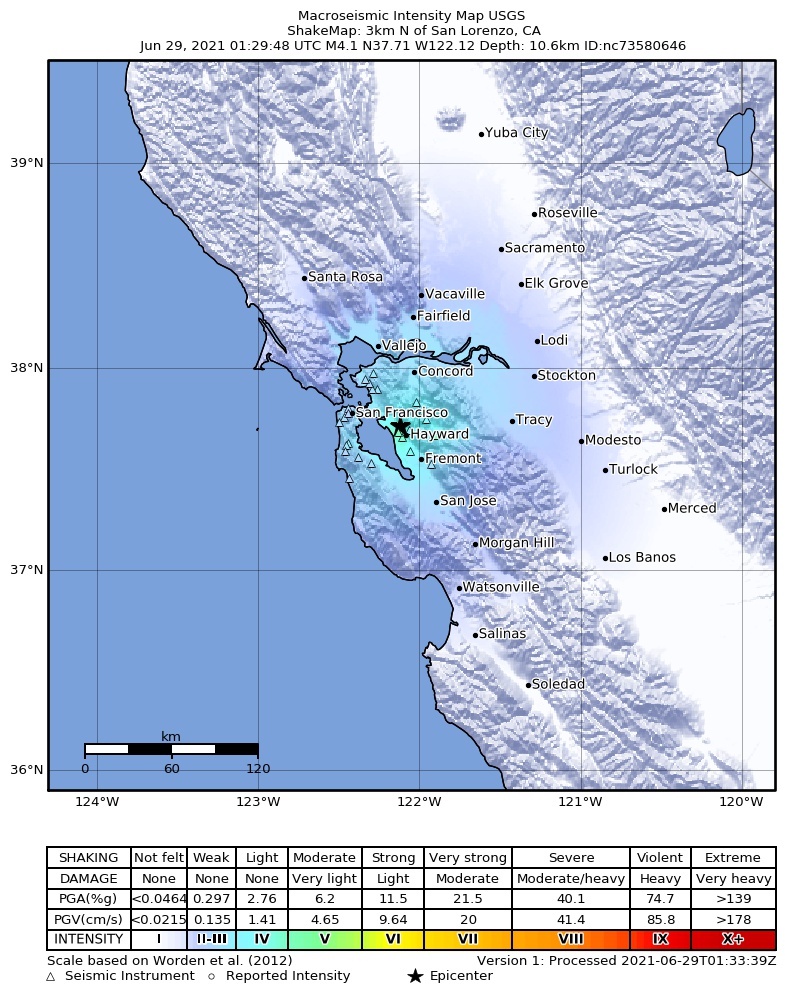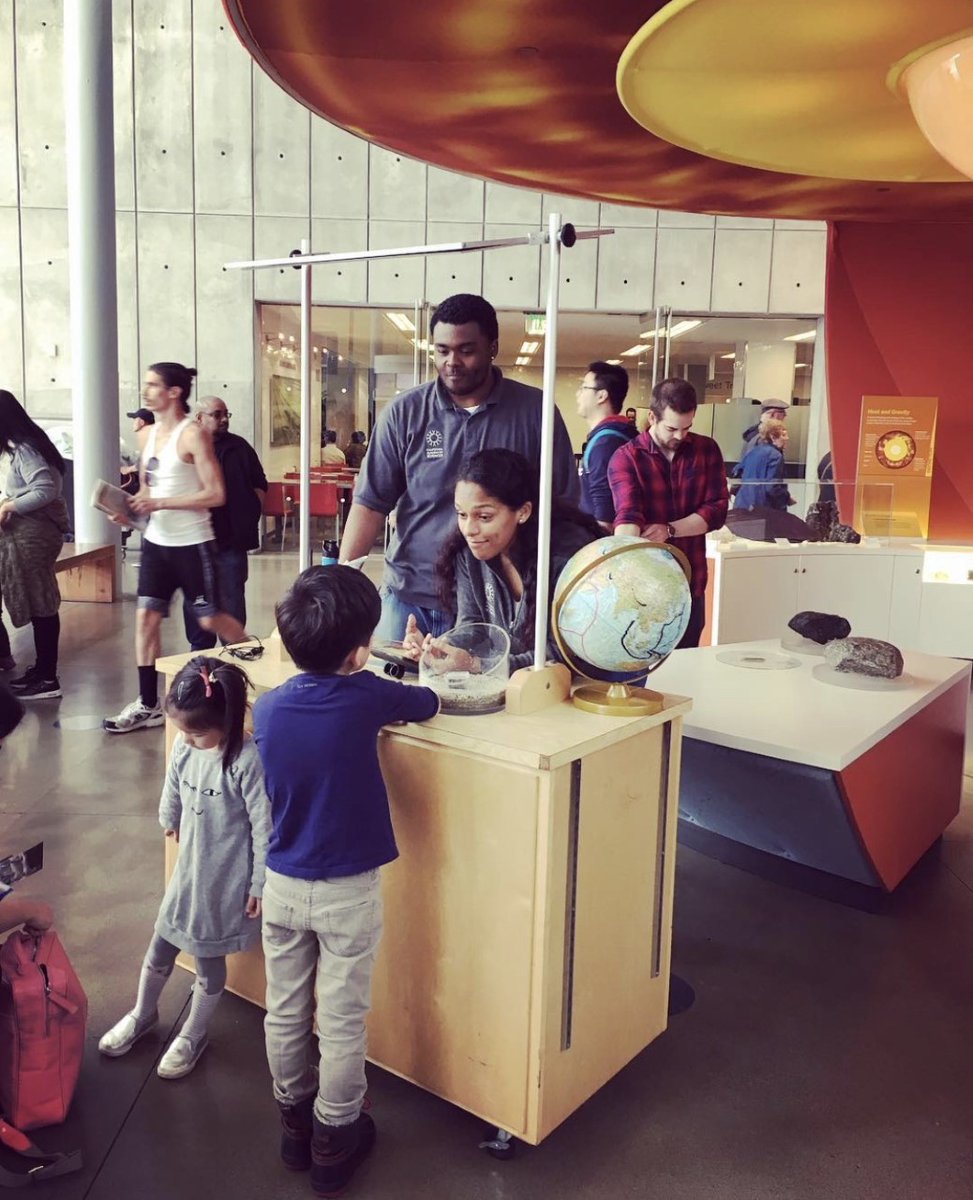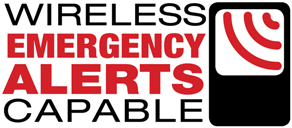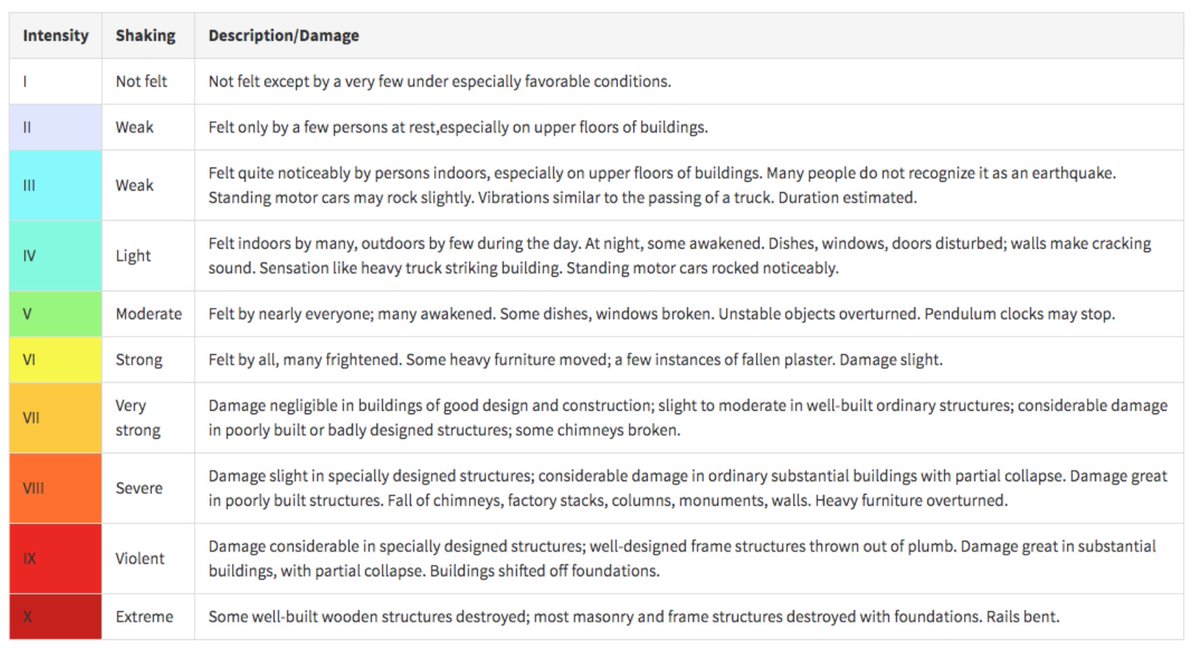Discover and read the best of Twitter Threads about #ShakeAlert
Most recents (24)
Massive 6.4 #earthquake rocks #California leaving people without power | Dec 20
- Its #epicenter was 210 miles north of #SanFrancisco, where a quake hit last week
dailymail.co.uk/news/article-1…
- Its #epicenter was 210 miles north of #SanFrancisco, where a quake hit last week
dailymail.co.uk/news/article-1…
Why “Drop, Cover, and Hold On” when you get a #ShakeAlert-powered alert📱? How do we know this is the best action to take? Check out this social science research! library.seg.org/doi/10.1190/ge…. Let’s dive in 🧵. @Cal_OES @ShakeOut @waEMD @OregonOEM @CAGeoSurvey @RocketRules1 @ECA
For a successful #EEW system to reduce injuries, 3 things should be considered: 1) the people who are alerted and the building types they occupy, 2) demographic variables such as gender, age, as well as quake experience & 3) types of quakes and performance of the EEW system. 

The #ShakeAlert team analyzed earthquake injuries and deaths, focusing on quakes from the 1970s to now. Several studies from CA (Loma Prieta & Northridge) and WA (Nisqually) showed that people who move during shaking are twice as likely to be injured than those who don’t. @fema 

Good evening Bay Area! Did you feel the M4.0 quake about 2 mi N of San Lorenzo? The #ShakeAlert system detected the quake. The event wasn't large enough for #ShakeAlert-powered alerts to be distributed to phones but at this magnitude automated actions could be triggered.@Cal_OES 

Learn more about what #ShakeAlert did during the quake: earthquake.usgs.gov/earthquakes/ev…. @USGS had the first data package ready (a #ShakeAlert Message) in 4 sec (about 10 blinks of an eye). The 8-sided polygons represent the estimated shaking that people could feel at various locations. 

#ShakeAlert provides an estimate of what people could feel during an earthquake. Everyone experienced a M 3.9 (recently revised) quake but what you felt is dependent on many factors such as distance from the epicenter. Learn more: earthquakecountry.org/putting-down-r… @ECA @ShakeOut @Cal_OES 

A shaky afternoon in Southern California. Hope everyone is safe. Did you feel the M4.9 #earthquake near Westmorland at 5:31 pm PT? The #ShakeAlert system issued a message and passed it along to our delivery partners. If you received a message, share a screenshot with us! 

.#ShakeAlert powered #earthquake alerts were delivered by the @MyShakeApp and @fema Wireless Emergency Alert System - WEA. You can find this map at: prod-earthquake.cr.usgs.gov/earthquakes/ev… Check out the map - if you are inside the MMI 3 (weak) polygon you might have received an alert. 

Did you know that it is National Postdoc Appreciation Week #NPAW? For #ResearchFriday, we are focusing on the great work of our early career researchers! Currently we have four @USGS postdocs working to improve the #ShakeAlert system. Let the shout-outs begin! @USGS_Quakes 

Dr. Noha Farghal has a Ph.D. in geophysics from @Stanford. Noha is working on incorporating fiber-optic sensors into the #ShakeAlert system. Check out her recent paper: The Potential of Using Dynamic Strains in Earthquake Early Warning Applications pubs.geoscienceworld.org/ssa/srl/articl… 

.@UCLA Bruin Dr. Grace Parker studies ground shaking and works on models to better estimate ground motion in SoCal for #ShakeAlert & best practices for using @PEER_Center NGA-Subduction ground motion models for Cascadia in EEW algorithms.@UCLACivil @Garrickinstitut #PDAW2020 

A shaky Friday evening in Southern California. Hope everyone is safe. Did you feel the M4.6 #earthquake about 2 miles west of El Monte just before 11:39 pm PT? The #ShakeAlert system issued a message and passed it along to our delivery partners. More info: earthquake.usgs.gov/earthquakes/ev… 

Let us know if you got an alert and share screen shots if you want. At this magnitude apps that are Powered by #ShakeAlert can deliver alerts to people who could feel MMI III (weak shaking) or greater. Check out how big the MMI III+ region is on this map. @Cal_OES 

Check out the #ShakeAlert post-alert summary at: earthquake.usgs.gov/earthquakes/ev…. The first ShakeAlert Message was issued by @USGS 4.5s after the quake started. The quake was about 11 miles deep and it took about 3s for the first waves to reach the surface where they could be detected. 

Hi everyone, it’s #ResearchFriday! On top of having 60+ physical scientists on #ShakeAlert we have a team of 30+ social scientists who study human interaction with ShakeAlert. Meet the Social Science Working Group (SSWG). Here’s our class picture from 2020! 

Why is social science important? Apart from sensors in the field, data processing centers, and alert delivery by our partners, people directly interact with #ShakeAlert. Anything that can improve that interaction, which often happens quickly, is critical to keeping people safe. 

So what does the SSWG do? They work on research projects that are critical to improving #ShakeAlert…for you. That means everything from messaging to graphics to what channels to use to how groups use ShakeAlert is studied by SSWG. 

Happy #ResearchFriday! How does #ShakeAlert work and how do our 60+ partners use it to keep people safe? Here's the latest creation from @IRIS_EPO and the ShakeAlert Education & Outreach team - a new video to explain a pretty complex system. Please share! 

Even #ShakeAlert animations are based on research. What went into making this new resource? Every detail counts and geologist Jenda Johnson spent hours getting everything just right. Just to animate Drop, Cover, and Hold On took 100+ individual frames! @ECA @waShakeOut @ShakeOut
Then there’s the work of pulling a team together to develop the story, get the facts right, and manage the review process. #ShakeAlert team member and seismologist Dr. Danielle Sumy led a team of over 10 people who weighed in on all aspects of this project.
Meet our newest #ShakeAlert team member, recent @pitzercollege grad Mariah Jenkins. A double major in geology and environmental analysis, she will explore, design, and implement resources and programs that focus on access, inclusion, and diversity in ShakeAlert. 

Optimizing how 50+ million people interact with earthquake alerts is critical to the success of #ShakeAlert. Mariah is up for the task and she will be working with researchers at @OMSI and @UOsojc to apply what she learns to real world settings. @OregonOEM @waEMD @Cal_OES
At Pitzer, Mariah was a Robert Redford Conservancy Fellow. She worked with local community groups, indigenous community leaders, local politicians & students, on sustainability projects in Southern CA. At @calacademy she facilitated informal learning experiences. @rrconservancy 

It’s #ResearchFriday! Welcome Meredith Morgoch to the #ShakeAlert team! As a @UOsojc doctoral student at @uoregon, she’s studying how theory can inform the design of effective messaging that empowers people to perform preparedness practices and disaster mitigation behaviors. 

Throughout her career Meredith has focused on strategic communication, natural disasters, new media and technology, and citizen agency, all critical areas that will help us better understand and improve how people interact with #ShakeAlert.
The heart of Meredith’s research is to understand how diverse communities including the most vulnerable among us comprehend and act upon disaster and hazard information. Meredith’s results will improve the accessibility of #ShakeAlert for all people. @Cal_OES @OregonOEM @waEMD
Hi everyone! It’s #ResearchFriday! #ShakeAlert is constantly looking for ways to improve the System. One way we learn is to ask “What if?” questions. Today let’s ask: What if the ShakeAlert System had been operating with 2020’s technology during the 1994 Northridge earthquake?
At 4:30 am on 1/17/94 a M6.7 earthquake occurred near Northridge, CA. The shaking it generated caused damage throughout Los Angeles County, including the San Fernando Valley. There were 57 deaths, over 9000 injuries, and billions of dollars in property damage.
Our goal in studying this is to have a better idea how #ShakeAlert could perform for a moderate earthquake impacting a major urban area. 

Hi everyone, it’s #ReseachFriday! This week’s focus is on #ShakeAlert alerting regions! This study looked at using the 2019 Ridgecrest earthquakes to find an optimal alerting strategy. pubs.geoscienceworld.org/ssa/bssa/artic…
So, the #ShakeAlert system detects an earthquake, it uses ground motion models (GMMs) to determine the size of the alert region using earthquake source estimates as input (generally, magnitude and location). 

Welcome to #ResearchFriday where we highlight how we’re constantly improving the #ShakeAlert System whether it’s about Earth science, technology, alert delivery, or even how people and automated systems interact with alerts.
This week, it’s some social science! This study brought together many experts to figure out how to improve communication with people after a #ShakeAlert Message is issued and an alert is delivered to your phone or other wireless device.
A bit of a shaky morning in LA. Hope everyone is safe. Did you feel the M4.2 #earthquake about 1 mile north of Pacoima just after 4:29 am PT? The #ShakeAlert system issued a message and passed it along to our delivery partners. More info: earthquake.usgs.gov/earthquakes/ev… 

If you felt it please fill out a Did You Feel It report at: earthquake.usgs.gov/earthquakes/ev…
Thanks for all of your great reports on what you felt and whether or not you got an alert. The first #ShakeAlert message was issued by USGS 3.6 seconds after sensors detected the event and the last one was issued at 12.8 s. See: earthquake.usgs.gov/earthquakes/ev… 

We want to update you on yesterday’s M5.8 earthquake 11mi SSE of Lone Pine, CA. The #ShakeAlert-powered Apps and @fema WEA delivered alerts to thousands of people in Southern California. #QuakeAlertUSA @MyShakeApp @Cal_OES @EarlyWarningLab
(1/6)
(1/6)

Since October of 2019 the Wireless Emergency Alert (WEA) system and Apps have been undergoing the testing of public alerting in California. One advantage of WEA is that it can broadcast a single message to many people without overwhelming the cellular system. (2/6) 





#ShakeAlert works very quickly and the first estimate of the earthquake’s size was M5.0, big enough to alert people by WEA and Apps. As the earthquake grew in size #ShakeAlert issued updates to a growing area. (3/6) earthquake.usgs.gov/earthquakes/ev… 

Good morning! Check out the #ShakeAlert report for a M5.8 quake about 10 miles from Lonepine, CA. Alerts were delivered to wireless devices by @fema WEA and Apps. Did you get one? Please send us a pic! @Cal_OES earthquake.usgs.gov/earthquakes/ev… 

If you felt the earthquake please fill out a Did You Feel It Report at: earthquake.usgs.gov/earthquakes/ev… Thanks! 

Yesterday the #ShakeAlert team was working on code updates to improve Earthquake Early Warning (EEW) alert delivery by the Wireless Emergency Alert (WEA) system. To make sure the updates worked we ran a test using an example from the Ridgecrest/Trona region. 1/4 

Unfortunately, due to a technical glitch the test message was incorrectly sent to the communities in and around Ridgecrest and Trona. This is the first time a false alert was delivered to the public. 2/4
Our goal is to protect people and property from earthquakes and provide all people in CA, OR, and WA with a world class EEW system. 3/4
Did you feel the M3.7 #earthquake in L.A. just after midnight and wonder, “Hey, where's my alert on my phone?” Apps and @fema WEA didn’t deliver alerts because the event did not meet the minimum #ShakeAlert alerting thresholds for either delivery pathway. earthquake.usgs.gov/earthquakes/ev… 

Apps only deliver alerts to people who could feel MMI 3+ (weak shaking) or greater for quakes M4.5+ and @fema WEA alerts go to those who could feel MMI 4+ (light shaking) or greater for quakes M 5+.
Learn more about the ShakeAlert message issued for the M 4.9 earthquake - 10.5 mi ESE of Anza, CA at 6:53 pm PT. earthquake.usgs.gov/earthquakes/ev… @Cal_OES @CaltechSeismo @BerkeleySeismo 

An @fema WEA Alert was distributed for this earthquake. Currently WEA alerts are only delivered for earthquakes M5 and greater and only to those who could feel light shaking (MMI 4) or greater. If this quake was only M 4.9 why was a WEA delivered? 

Check out the ShakeAlert Post-Alert Summary at:earthquake.usgs.gov/earthquakes/ev… and look for the final ShakeAlert message. 

#ShakeAlert focuses on eq shaking which is controlled by 3 main factors: magnitude, distance from the rupturing fault, and local ground conditions. These factors play a role in how hard and for how long a region will shake. (1/5)
During an earthquake, loose, soft soil will shake harder and longer than hard rock. Valleys will shake harder than mountains because of their sediment fill. Watch this video from @IRIS_EPO (2/5)
Liquefaction occurs when loosely packed, water-logged sediments at/near the surface lose their strength in response to strong ground shaking. Liquefaction occurring beneath buildings and other structures can cause major damage during earthquakes. (3/5)
Check out the #ShakeAlert Post-Alert Summary for the M 5.2 earthquake - 8.7 miles W of Petrolia, CA at 3:08 pm PT earthquake.usgs.gov/earthquakes/ev… 

When the #ShakeAlert system issues a message for earthquakes M 5.0 and above a @fema WEA Alert gets sent to those who could feel MMI 4 (light shaking) or greater. Here's an example of what a user received on their phone. @Cal_OES @FCC 

Apps that are powered by #ShakeAlert also distributed an alert to those who could feel MMI 3 (weak shaking) or greater. If you received an alert from an app or WEA please share your experience. @MyShakeApp @EarlyWarningLab
Last night the USGS issued a #ShakeAlert for a M 5.5 quake in the Baja California-Sonora border region. See: earthquake.usgs.gov/earthquakes/ev… Look for the ShakeAlert link to learn more. (1/5) 

Light shaking (MMI 4) was outside of California so no @fema WEA ShakeAlert was distributed - see color scale for comparison. Even though this earthquake was outside the seismic network and harder to locate #ShakeAlert performed well. (2/5) 



The *final* quake location determined by the USGS National Earthquake Information Center (NEIC) and the location of the *initial* #ShakeAlert (at 13 seconds) differed by about 19 mi. When the final ShakeAlert was issued (at 15.4 s) the location improved (to about 5 mi). (3/5) 



In 1868, a magnitude 6.8 earthquake struck Hayward, CA - killing 30 people and causing widespread property damage. Shaking was so severe that nearly every building in Hayward was wrecked. (1/4) 

This animation shows what might happen in a future scenario of a magnitude 7.0 earthquake hitting the region. Pay attention to how the strongest waves (reddish hue) propagate away from the epicenter. Notice how they race toward the south? (2/4)
Today the @Caltech /USGS Earthquake Research Affiliates hosted the third #ShakeAlert communication & education workshop in Pasadena, CA. A fantastic group outreach experts discussed and gave excellent feedback on the development of EEW materials for WA, OR, and CA. 

We had representatives from a variety of sectors including health care, academia, city government, entertainment, and transportation. Thanks to all who have participated in the last three workshops. @CaltechSeismo 

The final workshop will be held on 2/19 in Northern California hosted by @ECA, @Cal_OES, and the @HaywardLibrary. @ShakeOut 






